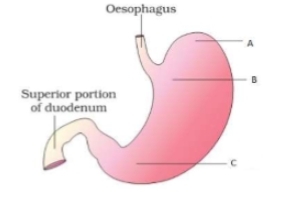In the given diagram showing anatomical regions of the human stomach, A,B and C respectively represent :

1. Fundus, Cardia and Pylorus
2. Cardia, Pylorus and Fundus
3. Fundus, Pylorus and Cardia
4. Pylorus, Cardia and Fundus

Starch is converted to disaccharide (maltose) by the action of:
(1) Sucrose
(2) Diastase
(3) Maltose
(4) Amylase
Pepsinogen is activated by:
(1) Trypsin
(2) Chymotrypsin
(3) HCl
(4) Na+
Pepsin converts:
(1) Protein into amino acid
(2) Fat into fatty acid
(3) Peptones into amino acid
(4) Proteins into proteoses and peptones (peptides)
Three secretions meeting the food in small intestine are:
(1) Bile, gastric juice and saliva
(2) Bile, pancreatic juice and gastric juice
(3) Pancreatic juice, intestinal juice and gastric juice
(4) Bile, pancreatic juice and succus entericus
Trypsinogen, chymotrypsinogen, procarboxypeptidase, amylase, lipase and nuclease enzymes are found in:
(1) Pancreatic juice
(2) Succus entericus / intestinal juice
(3) Gastric juice
(4) Bile and gastric juice
Bile produced in the liver is associated with which of the following?
(1) Emulsification of fats into tiny globules (micelles) in the small intestine by bile salts
(2) Digestive action of pancreatic amylase
(3) Emulsification of fats into tiny globules in the stomach
(4) Digestion of proteins into amino acids
Bile aids in digestion and absorption of fats because it contains:
(1) Lipase
(2) Bile salts
(3) Bile pigments
(4) All of the above
Emulsification of fat is carried out by:
(1) Bile pigments
(2) Bile salts
(3) HCl
(4) Pancreatic juice
Enterokinase / enteropeptidase takes part in conversion of:
(1) Pepsinogen to pepsin
(2) Trypsinogen to trypsin
(3) Protein into polypeptides
(4) Caseinogen into casein






